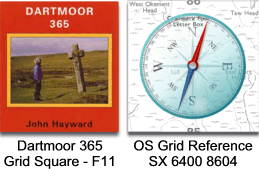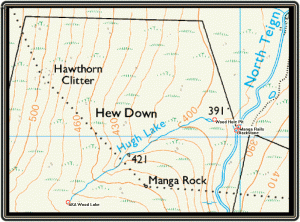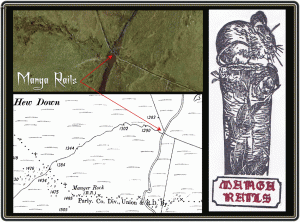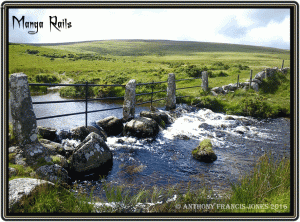
Both Mangersford and Manga Rails (which sound a bit like a 70s porn star) are landscape features located at and near to an old fording place on the North Teign river. As to the ford itself, William Crossing notes; “We shall also pass a fording place, which may possibly be the Mangersford mentioned in a pre-settlement at a Court of the Manor of Lydford, in the 2oth of Henry VI (1419).”, p.240. If true this would suggest that the old crossing place has been in use for many centuries and indeed is still used today. There are many place-names associated with the word ‘Manga’ in the area; Manga Brook, Manga Falls, Manga Hill, Manga Hole, Manga House and Manga Rock and more recently it seems ‘Manga Rails’. But if for the moment we stay with Mangersford it has been suggested by the English Place-Name Society that the name is formed from two elements: mangere and ford, mangere is an old Anglo Saxon word meaning merchant or monger, Clark Hall, p.229, and ford which is obvious. There are two possibilities to its meaning; firstly that the mangere could have been a personal name which would mean ‘The Merchant’s/Monger’s Ford’, Gover et. al. p.9, or secondly it may suggest a ‘ford used by merchants/mongers’. Just to confuse things a little more Brewer mentions that in a Duchy document of 1842 which described the Gidleigh bounds the name Manger Stone Ford appears, p.66. This would refer to the nearby Manga Rock which itself is a boundary point on the Gidleigh parish bounds. So here again we see another place-name where mangere has mutated to Manga. As if that’s not enough confusion I will at a bit more to the mix, Mike Brown mentions that very, very close to the Mangersford at the point where the Hew (AKA Wood) lake enters the North Teign is also known as ‘Blackstone’. He suggests that this name derived from the fact that at one time a bond mark of that name stood or still stands at this location, p.13. If would like another name for the collection then Hemery states at onetime a map of ‘Gidley’ showed the ford as Collinsford. He suggested that this name came from the fact that the ford was once regularly used by members of the Collins family from nearby Batworthy. p.819 fn.
OK, now for the main attraction – Manga Rails, clearly they are associated with Mangersford or else all of the above is pointless. But sorry to be a disappointment but today Manga Rails are simply a row of iron rails built across Mangersford, it’s as simple as that. However if you ever happen to be walking from say Shoveldon towards Watern Tor and the North Teign river is running high then Manga Rails won’t seem so insignificant. For this very reason Manga Rails have become an iconic landscape feature, so much so they have been the subject of several letterbox stamps over the years as can be seen below.
So basically what we have are four granite pillars that stretch across the North Teign river and support three rows and three sections of iron ‘rails’ as can be seen from the photograph below (many thanks to Anthony Francis-Jones for letting me use his photograph). Eric Hemery says: The ancient Mangersford (Manga Ford) is known, from the granite posts that once supported horizontal timbers, as ‘Rails’. These he suggests were put in place around 1780 in order to prevent livestock straying away from Teignhead Newtake, p. 819. Not only did the ‘rails’ prevent livestock from straying but they also provided hand holds when crossing the river on foot or if the waters were particularly high a means of crossing by sidling along the bottom rails.
At some point in the past the ‘rails’ were replaced by tubular iron bars (also called rails) due to decay and these too have been replaced several times. In 1991 they had fallen into a bad state of repair, one of the granite posts had been removed and seconded as a gate post in a nearby wall. Additionally the row of lower bars had disappeared, possible due to the fact that people (myself included) were sidling along them in order to cross the river. So the Dartmoor National Park Authority decided to take action and restored the missing granite post to its original position along with the missing lower line of ‘rails’. However by 2014 Manga Rails had once again fallen into a state of disrepair with the lower bars once again distorted by the weight of moorland travellers sidling along them. Again the D.N.P.A. initiated some more repairs, two new ‘rails’ were order in from Conibear Brothers of Crediton and the job of placing new metal support fixings for the bars went to a local blacksmith. After the work had been completed Manga Rails was once more in spick and span condition with new rails firmly fixed and a new coat of paint for good measure. I wonder how many more bodies sidling along the rails will it take before once again repair work is needed?
Incidentally, if you ever have a desire to see a Dartmoor piskie and happen to be at Mangersford just take a wander about a kilometre upstream from the ford to Manga Hole. It was here that a man once decided to take a break beside the Manga Falls. Whilst sat there happily minding his own business he noticed small pebbles landing in the nearby water but could not see from whence they came. Bravely he got up to investigate who or what was pestering him but alas could find hide nor hair of a living soul so he went back to sit beside the falls. No sooner had he settled down that the pebbles once again began to fall into the water in front of him. All this time he had the eerie felling of something or someone intently watching him, it was like pairs of eyes boring into his back. So enough was enough and the man sped off at full pelt not wishing or wanting to know what he had encountered but the thought of being piskie led was ample reason to vacate the area.?

Brewer, D. 2002. Dartmoor Boundary Markers. Tiverton: Halsgrove Publishing.
Brown, M. 1999. Dartmoor Field Guides – Vol. 37. Plymouth: Dartmoor Press.
Clark Hall, J. R. 2004. A Concise Anglo-Saxon Dictionary. London: University of Toronto Press.
Crossing, W. 1990. Crossing’s Guide to Dartmoor.Newton Abbot: Peninsula Press.
Gover, J. E. B., Mawer, A. & Stenton F. M. 1992. The Place Names of Devon. Nottingham: English Place-Name Society.
Hayward, J. 1991. Dartmoor 365. Curlew Publications.
Hemery, E. 1983. High Dartmoor. London: Robert Hale.

For 365-ers Hayward depicts both the Manga Rock and what he calls the “Hew Lake and stepping stones across the Teign,”, p.83. It’s interesting note that his sketch shows the granite piaalrs at Mangersford but no rails, clearly they were in the state of disrepair prior to the 1991 restoration work.
 Legendary Dartmoor The many aspects past and present of Dartmoor
Legendary Dartmoor The many aspects past and present of Dartmoor



